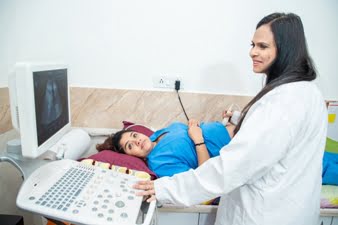Why is USG Breast Important?
Breast ultrasound plays a crucial role in the early detection and diagnosis of various breast conditions. It is often used as a complementary test to mammography, especially in certain cases where mammograms may not provide clear results. Here’s why this test is important:
1. Evaluation of Lumps or Masses: If you or your healthcare provider detect a lump in the breast during a physical examination, a USG Breast can help determine its nature. It can distinguish between solid masses (which could be benign or malignant) and fluid-filled cysts (which are typically benign).
2. Screening in Dense Breast Tissue: Mammograms may be less effective in detecting abnormalities in women with dense breast tissue because dense tissue appears white on a mammogram, similar to tumors. An ultrasound can provide a clearer view of the dense tissue and identify areas of concern that may not be visible on a mammogram.
3. Guidance for Biopsies: Ultrasound is often used to guide needle biopsies of breast lumps. It helps the physician accurately locate the area to be sampled, improving the precision of the biopsy.
4. Monitoring and Follow-Up: For patients with previously identified benign lumps or cysts, regular USG Breast exams can monitor any changes in size or appearance over time, helping to ensure that no malignant changes occur.
5. Assessment of Breast Infections or Inflammation: Ultrasound can help diagnose conditions like mastitis (infection of the breast tissue) or abscesses, providing detailed images that reveal the extent of the inflammation or fluid collection.
How is USG Breast R/L Performed?
1. Preparation: There is no special preparation required for this test. You will be asked to remove any jewelry or clothing from the upper body and wear a hospital gown. It is recommended to avoid applying lotions, powders, or deodorants before the procedure, as they can interfere with the ultrasound.
2. Procedure: The procedure is conducted while you lie on your back or slightly turned to the side. The ultrasound technician applies a water-based gel to the skin over the breast area to ensure good contact between the ultrasound probe and the skin. The transducer (ultrasound probe) is gently moved over the breast tissue. The sound waves emitted by the probe bounce off internal structures and return as echoes, which are then translated into real-time images on a monitor. The technician will examine both the superficial and deeper areas of the breast tissue, focusing on any areas where lumps or abnormalities are felt or suspected.
3. Duration: The examination usually takes about 15 to 30 minutes for each breast, depending on the complexity and whether both breasts are being examined.
4. Post-Procedure: After the ultrasound, the gel is wiped off, and you can resume your normal activities immediately. There is no recovery time needed, as the procedure is painless and non-invasive.
Who Should Consider a USG Breast R/L?
The USG Breast is suitable for various groups of individuals, particularly those with specific symptoms or risk factors. It is commonly recommended for:
1. Women with Lumps or Changes in the Breast: If you notice a new lump, swelling, or any other changes in the appearance or texture of your breast, an ultrasound can help evaluate the nature of these changes.
2. Women with Dense Breast Tissue: Those with dense breast tissue may benefit from a breast ultrasound in addition to a mammogram, as it can provide a clearer view of the underlying structures.
3. Young Women or Pregnant Women: For younger women or pregnant women, ultrasound is often preferred over mammography because it does not use ionizing radiation, making it a safer option.
4. Patients Needing Biopsy Guidance: Women who need a biopsy for a suspicious lump or area can undergo a guided ultrasound to ensure accurate sampling of the tissue.









